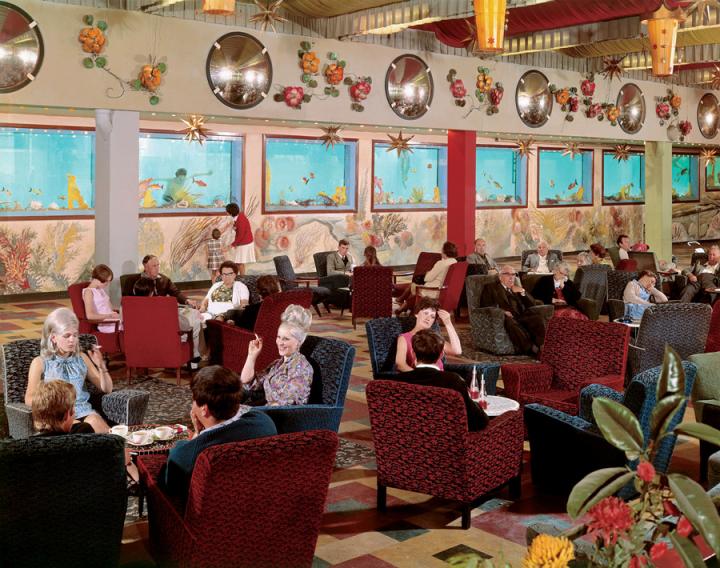
Lounge Adjoining Indoor Heated Pool, Butlin’s, Bognor Regis by Edmund Nägele, probably late 1960s
We take color imagery so completely for granted that it’s easy to forget how much it was once a selling point. In the 1960s, when the Butlin’s holiday camp company wanted to revamp its public image on promotional postcards, it turned to a publisher with a reputation for bright color pictures. The John Hinde Studio, founded in Ireland in 1956, boasted annual sales of 50 million postcards and it was one of the leading postcard producers in the world.
Hinde knew exactly what he wanted in a photograph and he trained his staff to achieve the desired effect. The Butlin’s pictures required considerable planning and it often took a whole day to set up a single large-format shot. When the time came, the “redcoats,” the resident Butlin’s entertainment officers, helped to move everyone into position. Massive amounts of flash flooded the curiously static tableaux—in bars, restaurants, ballrooms, and indoor swimming pools—with a dreamlike, color-saturated brilliance.
The compositions usually show panoramic group scenes, with dozens or hundreds of people, in which there is no obvious focal point and everyone merges into the contented crowd. Edmund Nägele’s picture of a quiet lounge at the Butlin’s camp at Bognor Regis, on Britain’s south coast, borders on lethargy. Two campers are sleeping and the woman in the pink top touching her hair looks far away and bored. Among the seated vacationers, only the smiling silver blonde guest with a jaunty cigarette shows much sign of having a good time. What small animation there is also comes from the little girl and the redcoat looking at the swimmer, who hangs eerily in the water behind the unrealistic fish painted on the glass.
“Everything in the place was cardboard make-believe,” Nägele later told an interviewer. He and his colleagues at John Hinde didn’t enjoy the holiday camps’ ambience of regimented cheerfulness and couldn’t wait to leave at the end of the day. Their task, which took about a week per camp, was to glamorize the Butlin’s experience, and with the grime-dispelling, color-liberating magic of the flashbulb they did so. The holidaymakers wear smart casual clothes and are always on their best behavior. There is never anything loud, lewd or unseemly. The elaborately populated scenes are like dioramas of late 1960s social life on display in a museum, and they have the same stylized calm and waxy remove. They convey a strictly idealized impression of what it would have been like to take a holiday at Butlin’s.
